How to Improve Your Balance
Each year, U.S. hospitals have 300,000 admissions for broken hips,
and falling is often the cause of those fractures. Balance exercises
can help you stay independent by helping you avoid the disability
often permanent that may result from falling.
As you will see, there is a lot of overlap between strength and
balance exercises; very often, one exercise serves both purposes.
About Strength/Balance Exercises
Any of the lower-body exercises for strength shown in the previous
strength section also are balance exercises. They include plantar
flexion, hip flexion, hip extension, knee flexion, and side leg
raise. Just do your regularly scheduled strength exercises, and
they will improve your balance at the same time. Also do the knee-extension
exercise, which helps you keep your balance by increasing muscle
strength in your upper thighs.
Safety
- Don't do more than your regularly scheduled strength-exercise
sessions to incorporate these balance modifications.
- Remember that doing strength exercises too often can do more
harm than good.
- Simply do your strength exercises, and incorporate these balance
techniques as you progress.
Progressing
These exercises can improve your balance even more if you add the
following modifications: Note that these exercises instruct you
to hold onto a table or chair for balance. Hold onto the table with
only one hand. As you progress, try holding on with only one fingertip.
Next, try these exercises without holding on at all. If you are
very steady on your feet, move on to doing the exercises using no
hands, with your eyes closed. Have someone stand close by if you
are unsteady.
Plantar Flexion
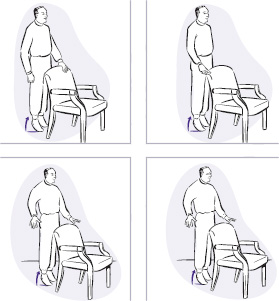 Plantar
flexion is already included in your strength exercises. When doing
your strength exercises, add these modifications to plantar flexion
as you progress: Hold table with one hand, then one fingertip, then
no hands; then do exercise with eyes closed, if steady.
Plantar
flexion is already included in your strength exercises. When doing
your strength exercises, add these modifications to plantar flexion
as you progress: Hold table with one hand, then one fingertip, then
no hands; then do exercise with eyes closed, if steady.
Summary:
- Stand straight; hold onto a table or chair for balance.
- Slowly stand on tip toe, as high as possible.
- Hold position for 1 second.
- Slowly lower heels all the way back down. Pause.
- Repeat 8 to 15 times.
- Rest; then do another set of 8 to 15 repetitions.
- Add modifications as you progress.
Knee Flexion
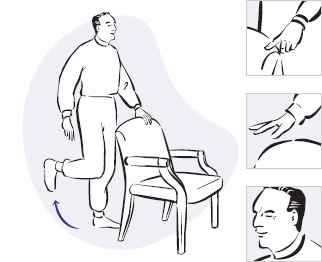 Do
knee flexion as part of your regularly scheduled strength exercises,
and add these modifications as you progress: Hold table with one
hand, then one fingertip, then no hands; then do exercise with eyes
closed, if steady.
Do
knee flexion as part of your regularly scheduled strength exercises,
and add these modifications as you progress: Hold table with one
hand, then one fingertip, then no hands; then do exercise with eyes
closed, if steady.
- Stand straight; hold onto a table or chair for balance.
- Slowly bend knee as far as possible, so foot lifts up behind
you.
- Hold position for 1 second.
- Slowly lower foot all the way back down. Pause.
- Repeat with other leg.
- Alternate legs until you have done 8 to 15 repetitions with
each leg.
- Rest; then do another set of 8 to 15 alternating repetitions.
- Add modifications as you progress.
Hip Flexion
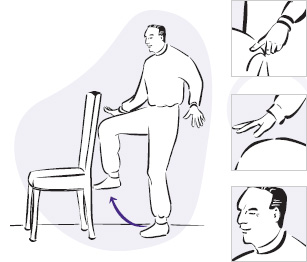 Do
hip flexion as part of your regularly scheduled strength exercises,
and add these modifications as you progress: Hold table with one
hand, then one fingertip, then no hands; then do exercise with eyes
closed, if steady.
Do
hip flexion as part of your regularly scheduled strength exercises,
and add these modifications as you progress: Hold table with one
hand, then one fingertip, then no hands; then do exercise with eyes
closed, if steady.
- Stand straight; hold onto a table or chair for balance.
- Slowly bend one knee toward chest, without bending waist or
hips.
- Hold position for 1 second.
- Slowly lower leg all the way down. Pause.
- Repeat with other leg.
- Alternate legs until you have done 8 to 15 repetitions with
each leg.
- Rest; then do another set of 8 to 15 alternating repetitions.
- Add modifications as you progress.
Hip Extension
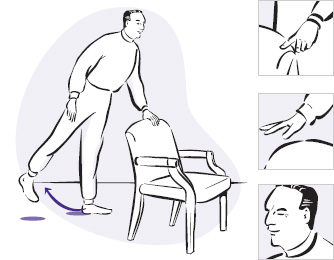 Do
hip extension as part of your regularly scheduled strength exercises,
and add these modifications as you progress: Hold table with one
hand, then one fingertip, then no hands; then do exercise with eyes
closed, if steady.
Do
hip extension as part of your regularly scheduled strength exercises,
and add these modifications as you progress: Hold table with one
hand, then one fingertip, then no hands; then do exercise with eyes
closed, if steady.
- Stand 12 to 18 inches from a table or chair, feet slightly apart.
- Bend forward at hips at about 45-degree angle; hold onto a table
or chair for balance.
- Slowly lift one leg straight backwards without bending your
knee, pointing your toes, or bending your upper body any farther
forward.
- Hold position for 1 second.
- Slowly lower leg. Pause.
- Repeat with other leg.
- Alternate legs until you have done 8 to 15 repetitions with
each leg.
- Rest; then do another set of 8 to 15 alternating repetitions.
- Add modifications as you progress.
Side Leg Raise
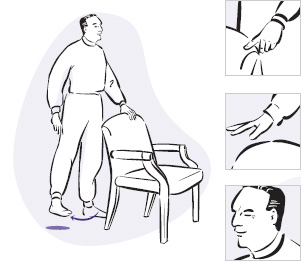 Do
leg raise as part of your regularly scheduled strength exercises,
and add these modifications as you progress: Hold table with one
hand, then one fingertip, then no hands; then do exercise with eyes
closed, if steady.
Do
leg raise as part of your regularly scheduled strength exercises,
and add these modifications as you progress: Hold table with one
hand, then one fingertip, then no hands; then do exercise with eyes
closed, if steady.
- Stand straight, directly behind table or chair, feet slightly
apart.
- Hold onto table or chair for balance.
- Slowly lift one leg to side 6-12 inches out to side. Keep your
back and both legs straight. Don't point your toes outward; keep
them facing forward.
- Hold position for 1 second.
- Slowly lower leg all the way down. Pause.
- Repeat with other leg.
- Alternate legs unti you have done 8 to 15 repetitions with each
leg.
- Rest; then do another set of 8 to 15 alternating repetitions.
- Add modifications as you progress.
Anytime/Anywhere
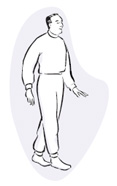 These
types of exercises also improve your balance. You can do them almost
anytime, anywhere, and as often as you like, as long as you have
something sturdy nearby to hold onto if you become unsteady.
These
types of exercises also improve your balance. You can do them almost
anytime, anywhere, and as often as you like, as long as you have
something sturdy nearby to hold onto if you become unsteady.
Examples:
- Walk heel-to-toe. Position your heel just in front of the toes
of the opposite foot each time you take a step. Your heel and
toes should touch or almost touch. (See Illustration.)
- Stand on one foot (for example, while waiting in line at the
grocery store or at the bus stop). Alternate feet.
- Stand up and sit down without using your hands.

